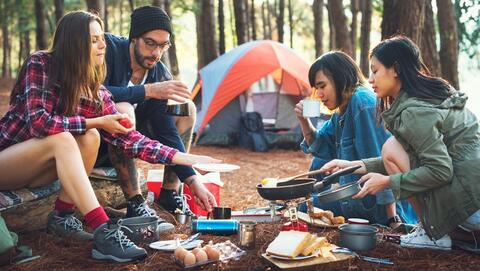Hiking and camping are perfect Labor Day weekend activities, and there's something special about enjoying a meal while admiring nature. To ensure your experience stays foodborne illness free, follow these food safety tips.
Avoid the "Danger Zone"
Bacteria multiply rapidly between 40 F and 140 F, aka the "Danger Zone." If you're packing perishable foods, keep them cold (below 40 F) by using a cooler or insulated container with cold sources like ice, gel packs, or frozen water bottles.
Follow the 2-hour rule and don't leave your perishables at an unsafe temperature above 40 F for more than 2 hours, or 1 hour if it's a hot day (above 90 F). This also applies to most sandwiches!
Clean Hands
It's important to clean your hands when handling food. Washing hands with soap and water is the most effective, but if you're hiking or preparing food at a campsite without easy access to running water, have hand sanitizer (at least 60 percent alcohol) or moist towelettes available.
Use a Food Thermometer
Grilling burgers over the campfire? Make sure to pack a food thermometer. All raw meat and poultry must reach a safe minimum internal temperature before they are safe to eat.
Cook burgers made with ground beef, pork, veal, or lamb to 160 F and poultry burgers to 165 F as measured by a food thermometer. Cook whole cuts of beef, pork, veal, or lamb to 145 F with a 3-minute rest time, fish to 145 F, and all poultry to 165 F.
Plan Ahead
Have questions about how to best prepare for your hiking or camping adventure? Call or email the USDA Meat and Poultry Hotline for advice from a food safety expert: 1-888-MPHotline (1-888-674-6854) or MPHotline@usda.gov.
Access FSIS news releases and other information at www.fsis.usda.gov/newsroom. Follow FSIS on Twitter at twitter.com/usdafoodsafety or in Spanish at: twitter.com/usdafoodsafe_es.
Picture from USDA Website
